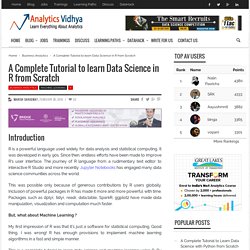

A Complete Tutorial to learn Data Science in R from Scratch. Introduction R is a powerful language used widely for data analysis and statistical computing.

It was developed in early 90s. Since then, endless efforts have been made to improve R’s user interface. The journey of R language from a rudimentary text editor to interactive R Studio and more recently Jupyter Notebooks has engaged many data science communities across the world. This was possible only because of generous contributions by R users globally. But, what about Machine Learning ? My first impression of R was that it’s just a software for statistical computing. This is a complete tutorial to learn data science and machine learning using R. Note: No prior knowledge of data science / analytics is required. Table of Contents Basics of R Programming for Data ScienceWhy learn R ? Let’s get started ! Note: The data set used in this article is from Big Mart Sales Prediction. 1. Why learn R ? I don’t know if I have a solid reason to convince you, but let me share what got me started.
Epistemic, ontological and aleatory risk « Critical Uncertainties. What do an eighteenth century mathematician and a twentieth century US Secretary of Defence have to do with engineering and risk?

The answer is that both thought about uncertainty and risk, and the differing definitions that they arrived at neatly illustrate that there is more to the concept of risk than just likelihood multiplied by consequence. Which in turn has significant implications for engineering risk management. Editorial note. I’ve pretty much completely revised this post since the original, hope you like it The concept of risk allows us to make decisions in an uncertain world where we cannot perfectly predict future outcomes. Which leads us to the point that Secretary Rumsfeld was making, that uncertainty is a continuum that ranges from that which we are certain of at one end through to that which we are completely ignorant of at the other.
Aleatory uncertainty At one end of the spectrum of knowing we have those things that we know and are confident we know. Notes 1. 2. 3. 4. Forecasting: principles and practice. Journal of Statistical Software — Index. Applied Time Series Analysis. Applied Time Series Part I. Cookbook for R » Cookbook for R. Time Series Analysis with R. Little Book of R for Multivariate Analysis. RStudio IDE. Writing R Extensions. Table of Contents This is a guide to extending R, describing the process of creating R add-on packages, writing R documentation, R’s system and foreign language interfaces, and the R API.

This manual is for R, version 3.1.0 (2014-04-10). Copyright © 1999–2013 R Core Team Permission is granted to make and distribute verbatim copies of this manual provided the copyright notice and this permission notice are preserved on all copies. Permission is granted to copy and distribute modified versions of this manual under the conditions for verbatim copying, provided that the entire resulting derived work is distributed under the terms of a permission notice identical to this one.
Acknowledgements The contributions to early versions of this manual by Saikat DebRoy (who wrote the first draft of a guide to using .Call and .External) and Adrian Trapletti (who provided information on the C++ interface) are gratefully acknowledged. 1 Creating R packages before reading on. A package is not1 a library.